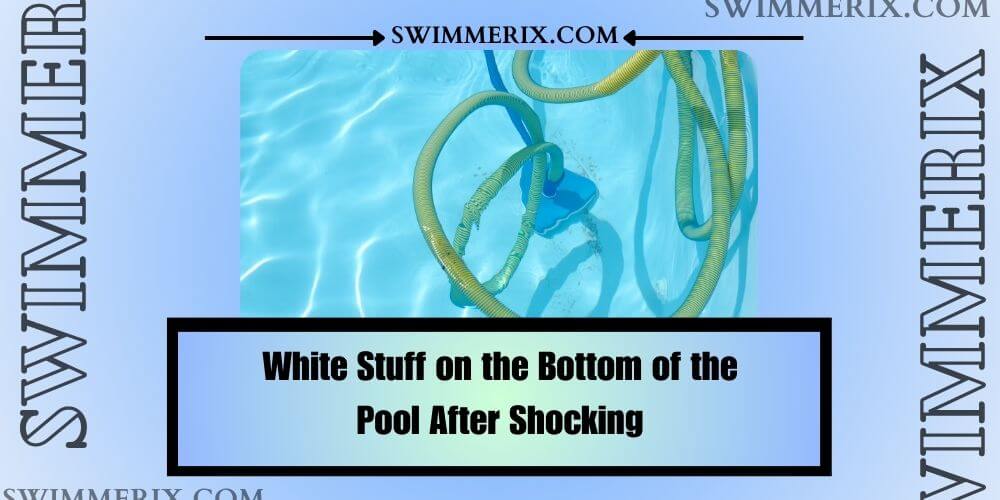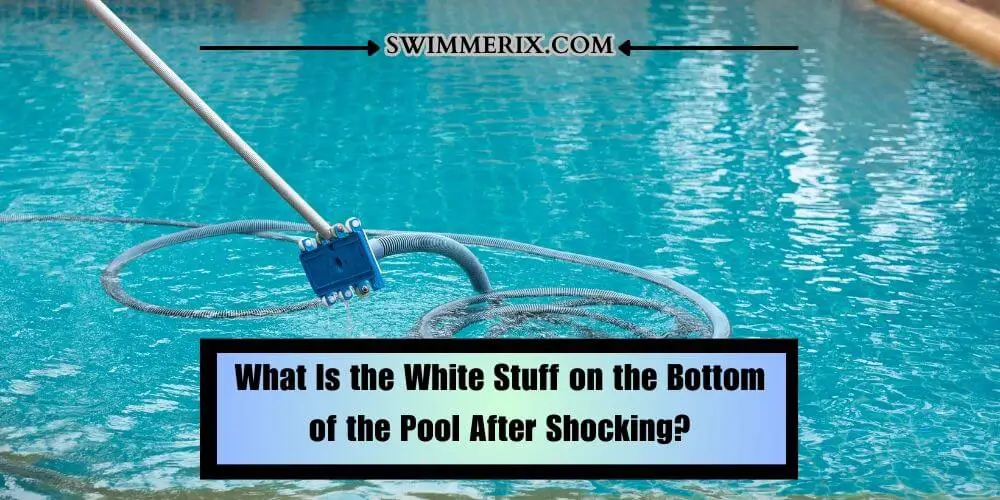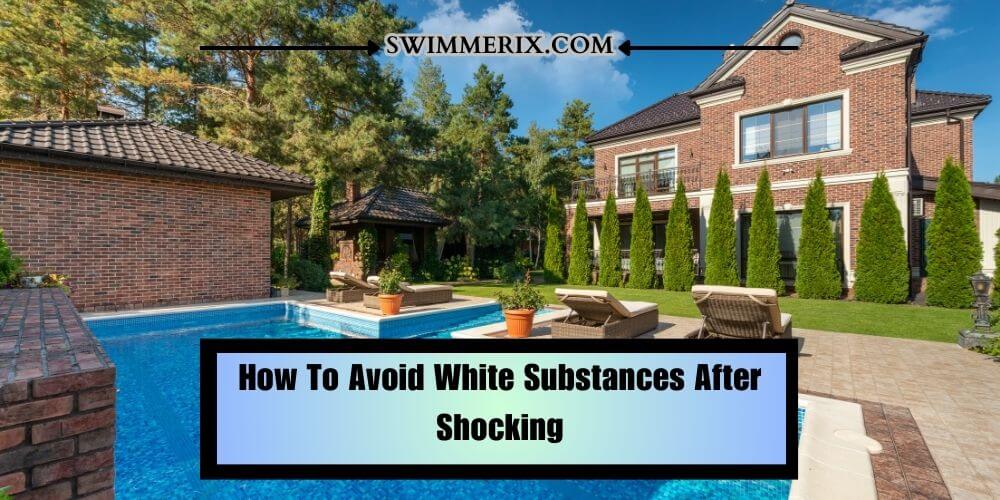
The aThe appearance of white stuff on the bottom of the pool can be a very unsightly & frustrating issue to encounter. Being a responsible pool owner, you must be worried about the appearance of white stuff on the bottom of the pool after shocking it.
Well, this issue can be perplexing, but we are here to help you learn what could be the causes behind this. If you are wondering what this white substance is, this article is for you. In this article, I will help you learn the signs behind the shocking pool and the causes of white stuff on the bottom after the shock.
Furthermore, I will also help you learn some practical steps that can help in keeping the pool water crystal clear. But before I tell you the causes of this white stuff’s appearance after shock treatment, let’s first understand what this white stuff is.
What Is the White Stuff on the Bottom of the Pool After Shocking?

If you notice white stuff on the bottom of the pool after shock treatment, then the chances are it’s a calcium deposit. You should know that calcium deposits are very common, especially when the calcium hardness level in the water becomes very high, causing the mineral to precipitate out of the water & settle on the pool surfaces.
There can be many causes behind the accumulation of calcium deposits on the bottom of the pool after shock; below, I will share all these. When you shock your pool, the pool shock agents release powerful oxidizers that attack organic matter in the water.
These oxidizers also work by breaking down contaminants into smaller _ harmless particles, reducing the risk of recreational water illness also caused by pathogens. Well, if the calcium hardness level is very high in your pool after water shock treatment, white or chalky substances may be spotted on the bottom of your pool.
However, you shouldn’t worry much, especially if you have just given your pool water a shock treatment which is a crucial aspect of pool maintenance to ensure the safety & well-being of swimmers.
A pool shock agent is very helpful, like chlorine or NonchlorinNonchlorinebreak down & neutralizes harmful substances while making the water sanitary and pleasant to swim in. Below I have shared some potential causes of calcium deposits after shock treatment in the pool.
Related Post: What Is White Stuff Floating in Pool?
What Causes of Calcium Deposits After Shocking
According to a study by the national swimming pool foundation, various factors can contribute to the formation of calcium deposits after pool shock. However, in most cases, high calcium hardness levels are the culprits.
If your pool calcium hardness level surpasses the recommended range of 200-400 PPM, the excessive calcium will fail to remain dissolved and will start to form into solid deposits. Other than this, sometimes poorly balanced pool water with high pH or alkalinity levels may encourage the precipitation of calcium deposits.
You should know that these calcium deposits can adversely affect your pool if left unattended. It will not affect the aesthetic appeal of your pool but also its functionality. Notably, calcium deposits usually contribute to the cloudy water, reducing the water clarity & making it appear less inviting for swimmers.
A study published by TMI Aquatics found that high calcium hardness levels can lead to scale formation on your pool surface or equipment, which might lead to costly repair on damages.
How To Avoid White Substances After Shocking

As the old saying goes, prevention is always better than cure, and the same holds for dealing with calcium deposits after shock. Below, I am mentioning some proactive steps that you must take to keep your pool free from pesky white substances.
Regular Water Testing & Monitoring
First, pay attention to regular water testing, an important part of maintaining the right chemical balance in your pool. I will strictly advise you to test the water at least once a week.
Also, it is recommended to test the water using a reliable testing kit after each heavy usage or sudden rainfall to ensure optimal conditions. CDC suggests maintain water chemistry, which is crucial to prevent RWIs and other pool relpool-related issues. The recommended water testing frequency and acceptable ranges are in the table.
| Test Parameter | Frequency | Acceptable Range |
| pH | Weekly | 7.2 – 7.8 |
| Alkalinity | Weekly | 80 – 120 ppm |
| Calcium Hardness | Monthly | 200 – 400 ppm |
Proper Pool Shocking Techniques
To minimize the chances of calcium deposits forming after shocking, I will advise you to follow these proper techniques and adhere to them.
- Choose the Right Shock Agent: First, choose a shock agent that suits your pool type and specific requirements. In most cases, chlorine shock is effective for regular maintenance, while nonchlorine shock is ideal for nonchlorine glass pools. Depending on the type & size of your pool, choose the right shock agent.
- Shock at Dusk or Night: If you want to help reduce chlorine degradation from sunlight, you must consider shocking your pool during the evening. You can also consider doing it at night, ensuring the shock treatment is more effective while chlorine is not degraded due to high sunlight exposure.
- Pre-dissolve the Shock Agent: Rather than pouring the shock agent directly into the pool, you must first dissolve it in a bucket of water. PreDissolving the shock agent in the bucket of water before adding it to the pool ensures even distribution while avoiding localized buildup.
Note: When giving a chlorine shock to a pool holding a size of 10000-20000 gallons, you should use 1-2 lbs of shock dosage. Alternatively, it would be best to consider using lbs of non-chlorine shock for pools of 100non-chlorine loss.
Treatment & Removal of White Substances
Sometimes despite your best effort, the white stuff on the bottom of the pool after shocking will still appear. But fear not; there are also many ways to address and remove these calcium deposits effectively and keep your pool water pristine.
However, before taking any collective measures, ensure that you confirm the white substance is indeed calcium deposits. You can do a simple test to identify them, like a vitamin C test.
You need to drop a vitamin C tablet on the stain, and if it is found to be lighter or disappears, the white substance is indeed a calcium deposit. Below is the table to help you understand the characteristics of calcium deposits vs other substances.
| Substance | Appearance | Vitamin C Test Result |
| Calcium Deposit | White, chalky texture | Lightens or disappears |
| Algae | Greenish, slimy | No change |
| Dirt/Debris | Brown, granular | No change |
If your test confirms the presence of calcium deposits, you can employ various treatment options to address the issue:
Chemical Treatment
Many treatment products are specially designed to dissolve & remove calcium deposits from any pool. However, consult first with a professional to determine the appropriate type of specialized pool scale remover or stain treatment product to effectively remove the deposits from the bottom of your pool. Also, be sure to follow the manufacturer’s instructions carefully.
Non-Chemical Treatment
If you want to go with a nonchemical approach, I will highly advise you to consider using a pumice Store or a nylon brush ll which are great at scrubbing away the deposits from the bottom of the pool.
However, you should note that this method is best suited for small-scale deposits and may not be a viable option for larger pools or commercial pools. Plus, if the calcium deposit is very severe or you don’t know the best course of action, it’s best to seek help from pool professionals. They will have the right expectation equipment to handle complex pool maintenance issues effectively & promptly.
Sequestering Agents
After addressing the calcium deposit properly, you might want to prevent this kind of issue from recurring in the future. If this is the case, I highly advise using sequestering agents known to bind the calcium ions and keep them suspended while preventing them from forming deposits.
| More Intriguing Topics |
| Can I Shock Pool After Adding Baking Soda |
| Why is the Pool Cloudy After Shock |
| Should You Filter or Recirculate Pool When Shocking |
Conclusion
Indeed dealing with white stuff on the bottom of the pool after shocking can be bothersome and frustrating for many people. But if you have the right knowledge & take the right preventive measures, you will be able to maintain a clean & inviting swimming environment.
Always note that regular pool shocking proper pool chemistry, and consistent maintenance are all the pillars of a pristine pool. Also, you should know that calcium deposits can be avoided with routine water testing & monitoring, balanced pool chemistry, and proper poor shocking techniques.
In case the white stuff does appear, you now have the right knowledge tools and measures to identify & address them effectively. Ensure you implement the tips & information shared in this article to keep your pool in top shape throughout the swimming session.
Aftershock, I have given you all the information needed to know what to do with the white stuff on the bottom of the pool. Check my other helpful guide on pool care & maintenance shared on this website.
If you find this article, consider sharing it. Your share will help many people learn about the calcium deposits problem and preventive measures. See you in the next post, till then, take care & goodbye.
